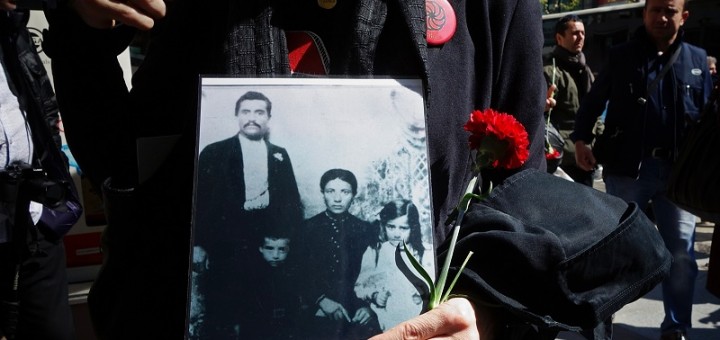
When violence enters the house, justice escapes through the skylight.
~ Armenian proverb
As an amateur observer of Turkey’s internal and external politics, it is strange to think back on my three visits to the country—June 2014, September 2015, and April 2015—when I was full of hope about reconnecting to the land where my grandparents were born. During the first journey—my Armenian Heritage Trip to Turkey, or Twenty Armenians on a Bus (with lots of jokes and weeping)—we covered about one third of the country, ranging from Istanbul to Mersin, from Adana to Aintab, from Ani and Van to Diyarbakir. While we were in Diyarbakir, we attended services at the beautifully restored Sourp Giragos Armenian Church in the city’s historic Sur district. In September 2014, I participated in the Istanbul meetings of Columbia’s Women Mobilizing Memory Workshop, deepening friendships with progressive Turkish academics and graduate students I had met under the workshop’s auspices. In April 2015, I was part of Project 2015, an effort to bring hundreds of Armenians from around the world to Istanbul to commemorate the Centennial of the Armenian Genocide. On April 24, we gathered with over ten thousand people in front of the French Consulate on Istiklal Avenue near Taksim Square for a vigil of remembrance, and my friend Heghnar Watenpaugh read a beautiful speech entitled “Let Us Make a New Beginning” in Armenian and Turkish.
Fast forward to the summer of 2015. (I won’t go into the complicated details of the June 2015 Turkish elections, but you can read about them here. The elections were “redone” in November 2015, and you can read about that here.) The peace process between Erdogan’s ruling AKP party and the Kurdistan Workers Party (PKK) fell apart, and the Turkish Army placed a number of Kurdish cities and towns under round-the-clock military curfew. Things devolved further in the Kurdish region during the fall of 2015 and the winter of 2016. The Kurdish population of Diyarbakir’s Sur was placed under military siege, and vast swaths of the neighborhood was laid waste. In March 2016, the Turkish government expropriated much of the district, including Sourp Giragos, and slated the area for “urban renewal.”
In January 2016, many progressive Turkish and Kurdish academics, horrified by the civilian casualties in the Kurdish region, signed and circulated a petition entitled “Academics for Peace” that called for renewed negotiations between the government and the Kurds. Erdogan branded the signatories traitors, and many were arrested and fired from their teaching positions. A number of international academic bodies circulated petitions in support of their colleagues in Turkey and of academic freedom.
This summer’s failed coup attempt only worsened an increasingly grim political situation. The military coup was a terrible idea—at least 290 people died, and more than 1,400 were wounded. It is good that it failed, but the subsequent crackdown has facilitated a witch-hunt against Kurds and progressive voices. Several pro-government figures intimated that Fethullah Gulen, Erdogan’s former ally and now the accused mastermind of the attempted coup, is in fact an Armenian. (After years of genocide denial and concomitant brainwashing, many in Turkey consider Armenians to be ultra-traitors, and there has been a recent uptick in anti-Armenian racism in political speech and the media.) As the Turkish ruling party rounded up accused coup-plotters, many opposition journalists, academics and writers have been detained. Many leaders in the People’s Democratic Party (HDP), a pro-Kurdish progressive alliance, who had already been subject to harassment and arrest starting in early 2016, are under further threat as they were excluded from a post-coup meeting between Erdogan and opposition parties.
The Turkish government’s machinations in Syria, where the Kurdish YPG (People’s Protection Units) are seen as a greater threat than ISIS, have always been complicated, as all parties in the region are playing double and triple games, with the U.S. trying to draw Turkey into the fight against ISIS while still maintaining its relationship with the YPG. Just this week, Turkish troops crossed the border into Syria with American air support, and they attacked NOT ISIS positions, but targeted YPG units in Jarablus and other Kurdish towns, killing and wounding dozens of civilians. The situation is still volatile, and it is unclear how all this will play out over the next month, although it appears that the U.S. may be abandoning their Kurdish allies. Also this week, the Turkish government conditioned permission for German lawmakers to visit the Incirlik Air Base on Germany’s stepping back from its recent recognition of the Armenian Genocide.
On April 24, 2015, before the commemoration began on Istiklal, I participated in an Armenian Wishing Tree “public art ritual” that I had helped to conceptualize. The tree was designed and created by Turkish artist Hale Tenger. I had brought a strip of cloth—actually the waistband of one of my grandmother’s half-aprons–with the names of my grandparents written on it to tie to the tree. Knotting the cloth to the tree was surprisingly moving—there was something about the individual gesture that made the clamor and crowds fade into the background and I was alone with my memory of my Armenian grandparents who had survived such horror, and alone also with sadness about what had been lost in these lands. Yet I was also united with the people—Armenians, Turks, Kurds, Greeks, and others—who joined me in tying their own wishes for a new beginning and a better future onto the tree. In the year-and-a-half since that moment, dark days have descended on many of those comrades, which makes our unity and shared destiny that much more precious than ever.
Nancy Kricorian
September 1, 2016